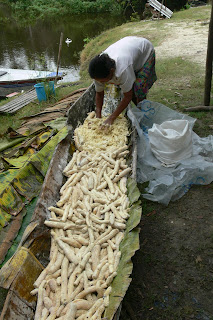 Building the oven in toasting hut
Building the oven in toasting hut Caring clay for the oven
Caring clay for the oven Ben is working hard, digging up clay for the oven
Ben is working hard, digging up clay for the oven
Life here is very different... everything moves much more slowly. For example yesterday and today we have been helping in the yuca or manioc (manihot esculenta) production of some local people. The process starts with harvesting the yuca (pronounced 'yoo-cuh', and and it is not the same as yucca!) from the field which takes some time because you have to use your canoe to get the farm which is located on higher ground, harvest, and then canoe back from the farm.
When you arrive back at your homestead, you have to peel the yuca, and then place the peeled yuca in a canoe or some other storage vessel, to sit for a few days. At Don Caesar and Isolina's house the peeled manioc was placed in a canoe and left underwater for a few days. When Ben and I arrived to help, we were able to help bale the water and manioc out of the canoe, and transfer the yuca to another container made out of wood pallets. This is basically allowing the yuca to rot a bit, so it softens up. After the yuca softens, it needs to be transferred to another container, and kneaded like bread dough into soft, pliable chunks. The kneaded yuca is then transferred to sacks and transferred to a press to have all of the moisture squeezed out. Ben and I were able to help construct the press and also to help constuct the toasting stove to be used later on in the process.
After about one day of being pressed the yuca was sufficiently dry to be grated over a large metal screen into very small particles. We removed any woody or rotted pieces during this part of the process and finally after about three days of preparation the toasting could begin!
The manioc processing is very slow, and involves lots of breaks to have refreshments, like "jungle milk" which was a delicious and soothing concoction of yuca and honey and I think evaporated milk?!
The toasting or cooking began, inside the structure that Don Caesar had built. We transferred the grated yuca into the large iron tray and put it over the fire. The smoke was pretty pungent and the cooking takes about 2 hours during which you are supposed to stand over the farina and stir the whole time, to keep it from sticking to the bottom. When the cooking of the manioc/yuca is completed the finished product is called "Farina". This is not the farina that some of us may be familiar with, but simply the toasted, cooked manioc root that is a staple of the local diet.
When completed the cooked manic resembles cornmeal and actually tastes a bit like roasted corn. We ate some raw and then stirred some into a cup of water which didn’t taste very good, but maybe with some honey it would have been better. However it is definitely very filling to eat so it does its job well as a staple food. We were given some farina to bring back to the lodge and some for Ben and I to bring home to the states. Farina apparently has a pretty long shelf life, about 6 months dry if I am remembering correctly. We also had some farina prepared for lunch, fried and salted and it tasted much better like granola or grape nuts and I think it would probably be really good with yogurt!


No comments:
Post a Comment